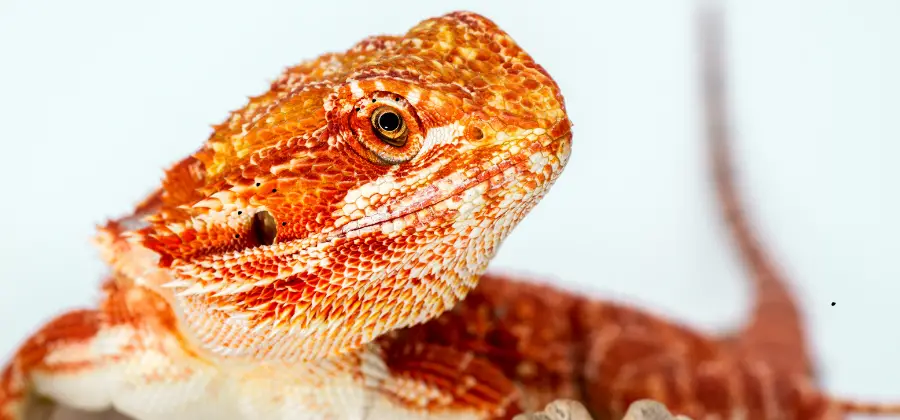Welcome, Bearded Dragon enthusiasts and owners! Today, we’re tackling a topic that’s crucial to the health and happiness of your scaly friends – ‘Bearded Dragon Mites’.
These tiny parasites can be a big nuisance, causing discomfort and potential health issues for your beloved Bearded Dragon. But fear not! Armed with the right knowledge, you can effectively prevent and treat mite infestations, ensuring your pet stays comfortable and healthy.
In this article, we’ll guide you through the process of identifying mite infestations, preventing them from occurring, and treating them effectively when they do occur. By the end of this read, you’ll be well-equipped to handle ‘Bearded Dragon Mites’ and provide the best care for your pet.
So, let’s dive in and learn how to keep these pesky parasites at bay!
How can I prevent and treat bearded dragon mites?
To prevent and treat bearded dragon mites, ensure good hygiene practices. Clean the water dish regularly and provide a dry environment to prevent moisture buildup.
For skin folds, gently clean them with a damp paper towel. If mites persist, a warm bath with soapy water can be effective. Additionally, monitor your dragon’s health and cleanliness from time to time to catch any signs of a potential snake mite infestation.
The Itch Factor: Understanding and Overcoming Bearded Dragon Mites

Bearded dragons are popular reptile pets known for their unique appearance, manageable size, and friendly nature. However, like any pet, they can become susceptible to various health issues.
One such issue that affects bearded dragons is an infestation of mites, which are tiny external parasites that feed on their blood and cause discomfort, stress, and health problems. Addressing these mite infestations is essential for maintaining the overall well-being of your bearded dragon.
Mites can be challenging to detect as they are usually small and hide well in the crevices of a bearded dragon’s body. Two types of mites commonly found in bearded dragons include Ophionyssus natricis, also known as the snake mite and Pterygosomid mites.
These mites often reside in skin folds and other hiding places such as around the eyes and mouth. When dealing with mite infestations, early detection, and effective treatment methods are crucial for ensuring the health of your pet lizard.
Various treatment options exist for addressing mite infestations in bearded dragons, including chemical treatments, natural remedies, and biological control agents.
One promising biological control agent is Stratiolaelaps scimitus, a predatory soil mite that has been shown to effectively eliminate parasitic mite infestations in lizards within just five days.
As a responsible bearded dragon owner, it’s essential to pay close attention to your pet’s health and take corrective action when necessary to tackle issues like mite infestations.
Bearded Dragon Mites: Overview

What Are Mites?
Mites are small arthropods that belong to the class Arachnida, closely related to spiders and ticks. They are parasites that can infest various animals, including reptiles like bearded dragons. There are several species of mites that can affect bearded dragons, with the most common being the parasitic mite Ophionyssus natricis, also known as the snake mite.
Bearded dragons, or Pogona vitticeps, are a species of lizard that are popular as pets due to their docile nature and ease of care. However, like any reptile, they can be prone to mite infestations if proper care is not taken.
Why Mites Are a Problem
Mite infestations in bearded dragons can cause a variety of health issues and complications. Some of the problems associated with mite infestations are:
- Discomfort: Mites can cause significant discomfort to bearded dragons due to their feeding habits, as they pierce the lizard’s skin to feed on their blood. This can lead to itching and agitation.
- Skin issues: Mite infestations can damage the bearded dragon’s skin, leading to open wounds, infections, and scarring.
- Anemia: As mites feed on the reptile’s blood, severe infestations can lead to anemia, a condition where the body lacks enough red blood cells to carry oxygen to its tissues.
- Stress: Mite infestations can cause stress in bearded dragons. Prolonged stress may weaken their immune system, making them more susceptible to other illnesses.
- Secondary infections: The open wounds from mite bites can serve as entry points for bacteria, leading to secondary infections that can have serious consequences for the lizard’s health.
Early detection and treatment of mite infestations are critical to preventing these issues and ensuring the well-being of your bearded dragon. One study showed that using the predatory soil mite Stratiolaelaps scimitus as a biological control agent was able to eliminate parasitic mite infestations in bearded dragons within five days source.
Wanna know How to Care For Lizards with Parasites? Watch this video:
Identifying Mite Infestations
Symptoms of Mite Infestations
Mite infestations in bearded dragons can cause various symptoms, making it crucial for owners to recognize these signs to provide timely treatment. One common symptom is frequent itching and rubbing against surfaces, which indicates the dragon’s attempt to relieve the irritation caused by the mites.
Another symptom is lethargy, as mite infestations can weaken the bearded dragon’s immune system and reduce its overall energy levels. Additionally, infestations may cause a decrease in appetite, making it essential to monitor your bearded dragon’s eating habits.
Physical Signs of Mites
Apart from the symptoms, there are also specific visual cues to identify a mite infestation. One of the most discernible signs is the appearance of tiny black or red dots on the bearded dragon’s skin.
These dots are the mites themselves, which typically measure between 0.5 to 1 millimeter in length. You may also spot small white or cream-colored eggs on the dragon’s skin, indicating the presence of mites.
Another physical sign involves the dragon’s shed skin. Mite infestations often lead to crusty or abnormal shedding, making it difficult for the dragon to shed its skin completely. You may also notice mites or their eggs on surfaces within the enclosure, such as bedding, rocks, or branches.
Regularly inspecting your bearded dragon’s living environment can help you identify the onset of an infestation.
Remember, early detection and intervention can effectively manage mite infestations in bearded dragons. By being aware of the symptoms and physical signs, you can ensure the health and well-being of your pet.
Conclusion: Bearded Dragon Mites

In conclusion, it is crucial for bearded dragon owners to be vigilant in preventing and treating mites. Regularly clean the water bowl and maintain proper hygiene practices. Look out for signs of mites, such as dead skin and external parasites, and seek medical attention if needed.
Nutrient-rich foods and proper treatment can help eliminate mites and prevent common issues. Remember, prevention is key, so practice hygienic measures and be cautious when handling infested reptiles, as mites can pose risks to both the dragon and human health.
Additionally, it is important to be aware of different mite species that can affect your bearded dragons, such as storage mites and harvest mites. If you notice any signs of mites, such as respiratory infections or human skin irritation, take immediate action. Proper treatment, including the use of mite-killing medications, should be administered for a couple of weeks to ensure the complete eradication of these pests.
Remember to practice preventative measures, such as regular cleaning and maintaining hygienic practices, to minimize the risk of mite infestations. By following these guidelines and seeking medical attention when necessary, you can ensure the health and well-being of your beloved reptile companion.
In addition to the aforementioned mite species, it’s crucial to address the presence of black mites, which can infest bearded dragons. Poor hygiene practices can contribute to the spread of these parasites. If detected, injectable medications are often prescribed for a specified period of time, typically a couple of weeks.
Maintaining a clean environment by using kitchen rolls and cotton buds, as well as regular vet visits, can help combat mite infestations. Pet expos should be attended with caution, as they can serve as a platform for the transmission of common parasites. Regular cleaning of glass tanks and food dishes, along with providing clean water, is essential to prevent parasitic infections.
Be aware of signs of diseases, such as metabolic bone disease and infectious stomatitis, and seek veterinary attention on a regular basis. Captive reptiles, including pet bearded dragons, should be considered potential hosts for various parasites, including white mites.
Detecting signs of bone diseases and administering appropriate deworming and insecticide treatments are effective methods for parasite control. Utilizing a spare tank and ensuring proper hygiene between tanks can minimize the risk of cross-contamination.
Timely detection of signs, such as eye infections and inactivity, allows for prompt treatment and reduces the likelihood of secondary infections. Addressing light issues and maintaining excellent hygiene are vital steps in parasite prevention.
Regular baths and using a layer of sand for entertainment should be conducted using chemical-free disinfection methods. Familiarizing yourself with common behaviors and engaging in entertaining interactions with your bearded dragon will promote their overall well-being.

